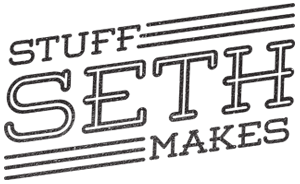Ever since my wife and I bought our house in 2011 we’ve tackled a lot of DIY projects. The biggest transformations have been the bathrooms and doing the bathrooms meant doing some tile work. If you’re like us, we thought “tile? no sweat!” but then in reality there actually was some sweat. There was even some frustration as we tried to get the surfaces of all the tiles to be flush with each other. Don’t get me wrong, it wasn’t the most difficult project in the world, and we’re still really happy with the work we did, BUT….had we known about these leveling spacers at the time…and had used them…we’d probably be even happier with our bathroom floors.
.jpg)
Fast forward to our family room makeover (we’re mid-project as of this blog entry). We have a brick hearth that needs to be tiled over and we have a small landing by the door that needs new tile. We decided this would be the perfect time to try out some leveling spacers. We bought all the tile from a nearby Floor & Decor and we noticed they had some tile spacers but we also thought, “are the tile spacers from Amazon any good?” So we decided to try the Amazon ones. How did it go? Keep reading to find out! 🙂
How Do I Use Tile Leveling Spacers?
To start, using leveling spacers for tile is very easy. First you spread the thinset and you lay down your first tile. Once the first tile is down you just slide one of the clear plastic spacers under the edge of your tile. Put 2 spacers per long edge, and lay down the next tile. Wiggle it into place, butting it up to your spacer and then you just slide the yellow wedge through the opening in the spacer. The system we bought included a tool similar to a pair of pliers and this tool allows you to push the wedge tightly into place. The wedges have a row of little ridges so they click and stay in place.
.jpg)
.jpg)
.jpg)
What Do I Do Next?
Once you’ve got your tile done, you stand back and look at your work and let the thinset dry for 24 hours. After that, it’s time to remove the wedges and spacers. At first, I thought I was supposed to take out the wedge and the spacer would simply break loose at the thinnest part of the spacer but that’s not what happened! Once your thinset dries and the tiles are permanent, there’s no way the spacers can wiggle side to side and break off. So I thought hmmm….these suck. But then I decided to look at the reviews and other people were saying to LEAVE THE WEDGE IN PLACE and just knock the spacer on the edge with a rubber mallet. So I tried that and voila! Perfect removal! Keep in mind the spacers are a one-time use part. Once you break them off, the bottom stays in the thinset and the top piece gets discarded. The wedges however, are reusable over and over and over. I’ll have links to these items a little further down this page.
.gif)
So now the two areas in our family room that needed to be tiled ARE tiled and we used these leveling spacers for both areas. I don’t really like tiling in general but now that I know my results are going to be better if I use these leveling spacers, I can at least suck it up and get through it, haha!
.gif)
We’re currently working on the rest of the family room makeover and as soon as that’s all finished, I’ll put a link to the video RIGHT HERE. Until then, make sure you jump up to the top of this blog post and watch the video of the tile leveling spacers.
If you’d like to try these spacers yourself, here are the ones we used:
DGSL Tile Leveling System: https://amzn.to/3j6oCFz
Extra Spacers: https://amzn.to/3rdA8Sc
*the links above are links to some products shown in this video (via Amazon). As an Amazon Associate I earn from qualifying purchases and any earnings made through these links helps me to be able to continue creating videos like these. I appreciate you purchasing items through my Amazon links!
Thank you so much for stopping by my page. I hope this information has been helpful as you start thinking about your next tile project. Have you tried using leveling spacers? What’s your experience been like? Good? Bad? Did you use this same style of leveler?
If you’re not already a subscriber to my YouTube channel, I’d love to have you. You can also follow me on Instagram and see more content. Have a great project!

.jpg)
.jpg)
.jpg)
.jpg)
.jpg)
.jpg)
.jpg)
.jpg)
.jpg)
.jpg)
.jpg)
.jpg)
.jpg)
.jpg)
.jpg)
.jpg)
.gif)
.gif)
.jpg)
.jpg)
.gif)
.gif)
.jpg)
.jpg)
.jpg)
.jpg)
.jpg)
.jpg)
.jpg)
.jpg)
.jpg)
.jpg)
.jpg)
.jpg)
.jpg)
.jpg)
.jpg)
.jpg)
.jpg)
.jpg)
.gif)
.jpg)
.jpg)
.jpg)
.jpg)
.jpg)
.jpg)
.jpg)
.jpg)
.jpg)
.gif)
.jpg)
.jpg)
.jpg)
.jpg)
.jpg)






